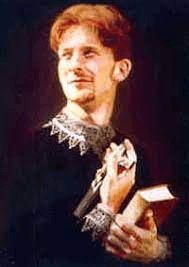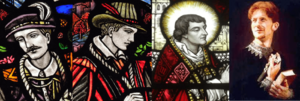Oaten Hill Martyrs facts for kids
The Oaten Hill Martyrs were a group of Catholic people who were put to death in a very harsh way at Oaten Hill, Canterbury, on October 1, 1588. A special gallows had been set up there in 1576. These four individuals were later recognized as "Blessed" by Pope Pius XI in 1929. This means the Catholic Church honors them for their strong faith.
Contents
The Oaten Hill Martyrs: Standing Strong for Their Faith
During the time of Queen Elizabeth I in England, there were big disagreements about religion. The Queen wanted everyone to follow the Protestant faith, but many people still believed in the Catholic faith. Because of this, some Catholics faced serious trouble, including being arrested or even executed. The Oaten Hill Martyrs were among those who died for their Catholic beliefs.
Robert Wilcox: A Young Priest
Quick facts for kids BlessedRobert Wilcox |
|
|---|---|
| Martyr | |
| Born | c. 1558 Chester, England |
| Died | 1 October 1588 (aged 29 - 30) Oaten Hill, Canterbury |
| Honored in | Roman Catholicism |
| Beatified | 15 December 1929 by Pope Pius XI |
| Feast | 1 October |
Robert Wilcox was born in Chester, England in 1558. When he was twenty-five, he went to a special school called a seminary in Rheims to become a Catholic priest. He became a priest on April 20, 1585.
He was sent back to England to help people practice the Catholic faith. But soon after he arrived in England on June 7, 1586, he was arrested in Lydd, Kent. He was taken to a prison called the Marshalsea.
On August 15, 1588, he was questioned. He bravely said he was a Catholic priest. He was then sent to Canterbury, England for trial with others. Robert Wilcox was the first of the four to be executed. He told his friends to be brave, saying he would go to heaven first and tell them he was waiting. He was about thirty years old when he died.
Gerard Edwards: Changing Names for Safety
Gerard Edwards was a Catholic priest born in Ludlow, Shropshire. He went to Jesus College, Oxford, but he left without finishing his degree. This was because he could not take the "Oath of Supremacy," which was a promise to accept the Queen as the head of the church.
On February 22, 1586, he left England to study to become a priest in Rheims. Many priests at that time used a different name, called an alias, to stay safer when they returned to England. Gerard changed his name to "Edward Campion" to honor another saint, Edmund Campion.
Because he was well-educated, he became a priest after only one year. He returned to England in the spring of 1587. Just a few weeks later, he was caught in Sittingbourne, Kent. He was held in Newgate and Marshalsea prisons in London. He was questioned by the Privy Council, a group of royal advisors.
On August 14, 1588, during another questioning, he admitted he was a priest. He was thirty-six years old when he was executed.
| Blessed Edward Campion |
|
|---|---|
| Martyr | |
| Born | Gerard Edwards c. 1552 Ludlow, Shropshire, England |
| Died | 1 October 1588 (aged 35 - 36) Oaten Hill, Canterbury |
| Honored in | Roman Catholicism |
| Beatified | 15 December 1929 by Pope Pius XI |
| Feast | October 1 |
Christopher Buxton: A Brave Young Man
Christopher Buxton was born in Derbyshire in 1562. He was a student at the Grammar School in Tideswell, Peak District. He went to the English College in Rheims in July 1581 to study for the priesthood.
In 1584, he went to the English College in Rome and became a priest on October 26, 1586. He had a long and difficult journey back to England. He was told to wait because the government planned to exile or execute priests. But Christopher decided to go to Kent in September 1587 anyway.
About two months later, he was arrested in Kent and taken to the Marshalsea prison. On August 15, 1588, he was questioned and admitted he was a priest. Because he was so young, people thought he might change his mind if he saw his friends die. He was offered his life if he would agree to the new Protestant religion.
But Christopher bravely said he would not buy his life at such a cost. He said if he had a hundred lives, he would give them all up for his faith. While in prison, he wrote a special book called a Rituale, which is a book of religious ceremonies. He sent this book to a priest as a last gift the day before he was taken from prison. He was taken to Canterbury for trial and execution. Christopher Buxton died at the age of twenty-six. He was also recognized as "Blessed" by Pope Pius XI in 1929.
| Blessed Christopher Buxton |
|
|---|---|
| Martyr | |
| Born | c. 1562 Derbyshire, England |
| Died | 1 October 1588 (aged 25 - 26) Oaten Hill, Canterbury |
| Honored in | Roman Catholicism |
| Beatified | 15 December 1929 by Pope Pius XI |
| Feast | October 1 |
Robert Widmerpool: A Supporter of the Faith
Robert Widmerpool was not a priest, but a layman, meaning he was a regular member of the church. He was born in Nottinghamshire. He went to Gloucester Hall, Oxford, but did not graduate.
He worked as a tutor for the Countess of Northumberland. He was arrested there because he helped a Catholic priest. He was put in the Marshalsea prison with the others.
When he was about to be executed, he thanked God for the chance to die in Canterbury. He said he was dying for the same reason St. Thomas had died there many years before. He was twenty-eight years old.
| Blessed Robert Widmerpool |
|
|---|---|

A painting of Blessed Robert Widmerpool by Paul Little, found in St. Margaret's Church in Keyworth.
|
|
| Martyr | |
| Born | c. 1560 Nottinghamshire, England |
| Died | 1 October 1588 (aged 27 - 28) Oaten Hill, Canterbury |
| Honored in | Roman Catholicism |
| Beatified | 15 December 1929 by Pope Pius XI |
| Feast | October 1, May 11 as one of the Nottinghamshire Martyrs |
See also
- Canterbury Martyrs - This article is about Protestant martyrs.
- Catholic Church in the United Kingdom
- Douai Martyrs
- Ralph Crockett
- List of Catholic martyrs of the English Reformation


